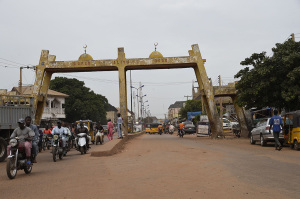Archaeological Discovery: Medieval Cities Hidden Under Cambodia's Angkor Wat

Archaeologists near Angkor Wat in Siem Reap, Cambodia, have used lidar technology to find medieval cities and waterways surrounding the temple that was built during the Khmer Empire.
The technology, which combines light detection and radar to survey areas, found a 734-square-mile area around Angkor Wat that previously served as home to sophisticated medieval cities, water structures and smelting areas.
Damian Evans, whose discovery was published in the Journal of Archaeological Science last week, tolde Guardian that the technology has allowed him and other archaeologists to get a better idea of how Southeast Asia functioned 900 to 1,400 years ago.
The advanced survey technology made it possible for researchers to uncover the ancient medieval cities buried around Angkor Wat, a large temple complex in Cambodia.
Evans told The Guardian that the discovery is likely as large as the country's capital of Phnom Penh.

"We have entire cities discovered beneath the forest that no one knew were there — at Preah Khan of Kompong Svay and, it turns out, we uncovered only a part of Mahendraparvata on Phnom Kulen … this time we got the whole deal and it's big, the size of Phnom Penh big," Evans told The Guardian.
Evans told the AFP that thanks to the lidar technology, researchers were able to get a clear view of the area surrounding Angkor Wat.
"We always imagined that their great cities surrounded the monuments in antiquity," Evans said. "But now we can see them with incredible precision and detail, in some places for the very first time, but in most places where we already had a vague idea that cities must be there."
"The lidar quite suddenly revealed an entire cityscape there with astonishing complexity," the researcher added.
In his recent journal report, Evans wrote that an especially interesting aspect of the ruins surrounding Angkor Wat is the existence of mysterious geometric patterns that some researchers believe were medieval gardens.
"Equally enigmatic are the geometric rectilinear patterns made from earthen embankments and variously described as 'coils,' 'spirals,' 'geoglyphs' or 'gardens,'" Evans wrote in his report. "Excavations of these linear features at Angkor have also revealed little of archaeological interest, and their function remains unclear."
According to the History channel, the recent find also sheds light on Cambodian history and the fall of the Khmer Empire in the 15th century.
As the media outlet reports, the discovery contradicts the previously-held belief that thousands of Cambodian inhabitants were forced to migrate from Angkor Wat in the 15th century, as there is no evidence indicating a mass migration.
There have been other important archaeological discoveries in Southeast Asia, including the Sungai Batu archaeological site in Malaysia, which researchers determined to be 2,000 years old, making it one of the oldest archaeological sites in the region.



























